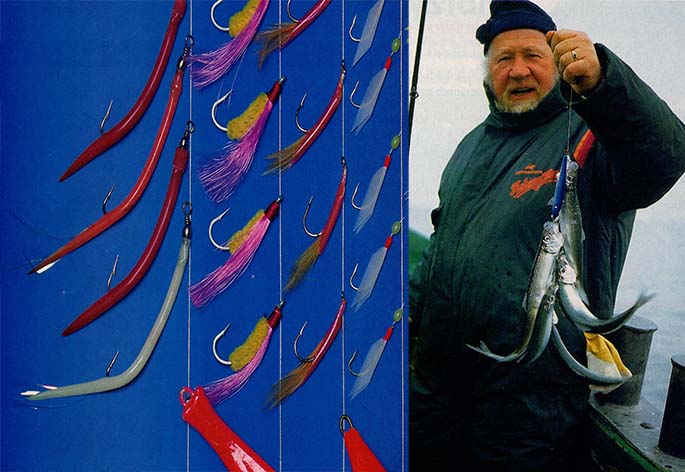 Dwie, cztery, a nawet sześć ryb za jednym pociągnięciem – coś takiego możliwe jest tylko na paternoster. Najczęstszą zdobyczą wędkarzy są śledzie, makrele i czarniaki. Paternostery to prawdziwe maszyny do łowienia ryb.
Dwie, cztery, a nawet sześć ryb za jednym pociągnięciem – coś takiego możliwe jest tylko na paternoster. Najczęstszą zdobyczą wędkarzy są śledzie, makrele i czarniaki. Paternostery to prawdziwe maszyny do łowienia ryb.
Systemy paternoster są maszynami do łowienia i nie ma w tym żadnej przesady. W Norwegii lub Islandii rybacy rzeczywiście łowią na paternostery maszynowo. Na przymocowanym do łodzi i napędzanym elektrycznie kołowrocie wielkości koła samochodowego z nawiniętą linką opuszczają cały zestaw na odpowiednią głębokość. Do końca linki przywiązany jest kilogramowy ciężarek naprężający cały zestaw (12 haczyków z przynętą). W pobliżu wybrzeży, jednak już na takiej głębokości, do której nie sięgają sieci, stoją duże czarniaki, rdzawce, dorsze, czerwone okonie morskie i chciwie rzucają się na wszystkie niesione prąciem morskim przynęty. Przyciskając guziki jeden rybak obsługuje jednocześnie trzy kołowroty z paternosterami. Jeden zestaw opada w głębinę, drugi jest już opuszczony i łowią się na niego ryby, trzeci zestaw znajduje się w łodzi i rybak odhacza wyciągnięte ryby. Po chwili znowu jeden paternoster opada, drugi łowi, a trzeci jedzie do góry. Za jednym wyciągnięciem udaje się niekiedy złowić nawet 25 kg ryb.
Tworzenie ławic
Łowienie na paternoster jest tak rewelacyjnie skuteczne jedynie dlatego, że wiele ryb morskich pływa w ławicach lub stadach. Na przykład makrele w Morzu Północnym tworzą latem olbrzymie ławice i zawzięcie polują na duży plankton zwierzęcy oraz na małe ryby. Makrele są w ciągłym ruchu i pływają jedna obok drugiej. Jeżeli wędkarzom uda się się trafić na ławicę, to łowienie do syta trwa najwyżej kilka minut. Makrele nagle gdzieś znikają i to tak niespodziewanie, jak się pojawiły. Ryby te pływają w toni wodnej, przeważnie do głębokości 15 metrów.
Ściśnięte śledzie
Śledzie także tworzą zwarte ławice, szczególnie w kwietniu i maju, gdy podpływają blisko brzegów. Niektóre ławice są olbrzymie, czasami jak okiem sięgnąć, inne bardzo małe, zaledwie kilkumetrowej długości. W ciągu dnia ryby przemieszczają się na głębokości od 1 do 3 metrów nad dnem i tam właśnie należy ich szukać. Czarniaki, których ostatnio latem jest chyba coraz więcej u naszych wybrzeży, zachowują się podobnie jak makrele. Do łowienia czarniaków najczęściej używa się pochodzących ze Skandynawii paternosterów z „gumowymi rurkami”. Dorsze i witlinki także żyją w stadach, szczególnie młodsze roczniki tych ryb. W odróżnieniu od ryb żerujących w toni, dorsze i witlinki szukają pokarmu tuż nad dnem. Tam też można je łowić na zestaw typu paternoster – wystarczy tylko powoli ciągnąć ciężarek po dnie i atrakcyjnie poruszać przynętami.
Delikatne podrygiwanie
Zasada łowienia na zestaw typu paternoster jest zawsze ta sama. Naprężony ciężarkiem zestaw opuszcza się na wybraną głębokość, a następnie zaczyna się nim delikatnie podrygiwać, aby sztuczne przynęty na trokach bocznych jak najwierniej imitowały coś żywego. Im mniejsze są przynęty, tym delikatniejsze powinny być ruchy wędkarza.
Kolorowe ciężarki
Do łowienia makreli i czarniaków używa się kolorowych ciężarków wabiących o masie od 80 do 150 gramów, natomiast do łowienia śledzi trójkątnych ciężarków o masie od 40 do 75 gramów. Specjalne ciężarki na śledzie poruszają się koliście w wodzie, dzięki czemu podczas podciągania małe przynęty zaczynają jeszcze atrakcyjniej pracować w wodzie. Nastawiając się na dorsze, zestaw paternoster obciążmy pilkerem o masie od 100 do 200 g. Pilker ten ma być płaski i powinien dobrze tańczyć w wodzie, dzięki czemu przynęty paternostera także będą lepiej pracować w wodzie. Paternoster nie może być dłuższy od wędziska, gdyż pojawiłyby się wtedy problemy z lądowaniem ryb. Wielu wędkarzy preferuje więc wędki o długości od 3,5 do 4,5 metra. Odstęp pomiędzy haczykami przywiązanymi na krótkich trokach bocznych do żyłki głównej powinien być trochę większy, niż spodziewana długość łowionych ryb. W praktyce oznacza to 30 cm dla śledzi, 50 cm dla makreli i 60 cm dla dorszy.
Sam paternoster powinien być wykonany z bezbarwnej, możliwie najmniej widocznej żyłki. Jest to ważne, gdyż dobrze widoczna żyłka bardzo płoszy ryby. Wytrzymałość żyłki, z której wykonany jest paternoster powinna odpowiednio wynosić: na śledzie dwa kilogramy, na makrele, witlinki i czarniaki około czterech kilogramów i na dorsze pięć kilogramów. Cały paternoster łączy się z żyłką główną poprzez solidny karabińczyk z agrafką. Agrafka musi być bardzo pewna i łatwo się otwierać, aby w każdej chwili można było wymienić zaplątany paternoster na nowy. Do łowienia z łodzi najlepszy jest multiplikator, gdyż łatwiej popuszczać z niego żyłkę przy opuszczaniu zestawu na odpowiednią głębokość. Kołowrotek o stałej szpuli jest lepszy jedynie do łowienia śledzi, gdy zestawem paternoster trzeba rzucać.
Więcej ryb na spokój
Po braniu należy zachować spokój. Wędkarz, który w takim momencie potrafi trochę poczekać, złowi znacznie więcej ryb. Pierwsza ryba porusza całym paternosterem i wywołuje u wielu ryb odruch konkurencji pokarmowej. Wędkarz musi zachować zimną krew, gdy czuje, jak druga, trzecia, czwarta, czy nawet piąta ryba atakuje pozostałe przynęty zestawu. Dopiero wtedy zaczyna nawijać żyłkę – w jednakowym tempie i bez holu.
Dlaczego bez holu? Dlatego, że każda ryba ciągnie w swoją stronę i jedynie zdecydowane nawijanie żyłki na kołowrotek zapobiega plątaniu się troków i odpinaniu się ryb przed wyjęciem z wody.
Po wyciągnięciu zestawu z wody należy odstawić pionowo wędkę i zacząć odhaczać ryby zaczynając od najniżej wiszących. Ryby wrzuca się do głębokiego wiadra, żeby żadna z nich nie wyskoczyła na pokład. Po odhaczeniu wszystkich ryb należy wszystkie je ogłuszyć i zabić. Im lepiej będą wykrwawione (przecięcie skrzeli), tym dłużej pozostaną świeże.
Jest to bardzo ważne, ponieważ morskie wyprawy na ryby trwają czasami kilkanaście godzin.